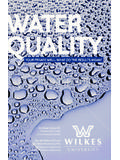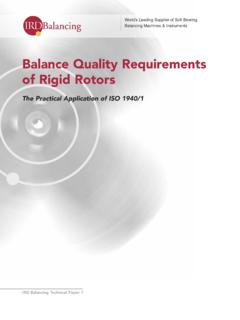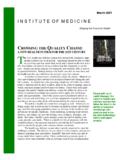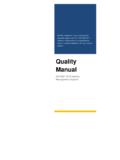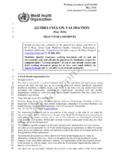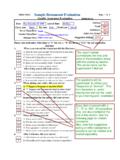Transcription of GIS QUALITY ASSURANCE – DATA ACCEPTANCE ... …
1 Swapan Nag and Brennen F. Sheperd Engineering Systems 355 South Grand Avenue, Suite 3292 Los Angeles, CA 90071-1560 and Thomas Conry County of Fairfax Department of Information Technology, GIS Group 12000 Government Center, Suite 117 Fairfax, VA 22035-0010 GIS QUALITY ASSURANCE data ACCEPTANCE SPECIFICATION & CONTROL ABSTRACT The QUALITY of a GIS model depends on specification of its content and accuracy and the QUALITY control methods used to measure adherence to these standards. Validation of the model involves checking for consistency between planimetric data and their corresponding physical features; cadastral data and source tax maps; adherence to graphics standards; and authentication of attributes for each of the entities.
2 To keep costs reasonable, the checking process is automated to the greatest extent possible, and benchmarks established as to how good is good enough. Report summaries are indispensable tools to provide an overview of error status and trends. The QUALITY control and ASSURANCE process is tracked from the initial product specification stage through the duration of the data conversion process and final product ACCEPTANCE . Survey control and registration of associated themes are discussed in terms of vertical and horizontal positional accuracy within a consistent coordinate framework. Pre-marking of facilities and use of existing benchmarks to serve as a cross-reference between photogrammetry, cadastre, and utility facilities is investigated.
3 Cartographic specification is analyzed in terms of conventional mapping and the comprehensive migration of information into a database format to ensure accuracy in spatial representation of feature entities and their attributes. The case of Fairfax County is cited: the GIS database comprising over 30 million graphic and attribute data elements, and features covering approximately 400 sq. miles. Both visual inspection and automated digital checking processes for QUALITY control are described. Detailed reports of errors and error trends have been developed and samples included in the discussion. Time estimates for corrections were developed to support decision making on error management.
4 This paper should be of interest to GIS and IS managers responsible for implementing or updating a GIS database, as well as staff involved in the data conversion process. INTRODUCTION GIS data conversion is, ideally, a production process designed to create a spatial database that conforms to a pre-defined specification. QUALITY is the degree to which the product conforms to the design specification (Adam and Ebert 1982). GIS QUALITY ASSURANCE (QA) is the process and practice whereby GIS data is reviewed for precision and accuracy in conformance to, or deviation from, a predefined standard or specification. The important characteristics that determine a product s QUALITY are shaped by (a) client expectation and (b) process capability.
5 At times, the two conflict, requiring resolution. Client Expectation data ACCEPTANCE Specification From the client perspective, QUALITY ASSURANCE confirms that data received form the conversion vendor meets the contracted standards of completeness, uniformity and conformance to specification. It reinforces the utility of the data in meeting user needs, and assures the client receives what was contracted for. Product specification as a condition of delivery ACCEPTANCE is an integral part of the procurement process. The specification may be introduced and evolved at several stages throughout the procurement cycle: Request for Proposal (RFP): A preliminary definition of the product specification should accompany the RFP prepared by the client.
6 Proposal: In their response to the RFP, the data conversion vendor has the opportunity to present a competitive assessment of proposed product QUALITY based primarily on process capability. Contract, Purchase Order and the Memorandum of Negotiation: During the vendor selection and contract negotiation phase, opportunity is provided for both client and vendor to modify their relative commitments to product specification and QUALITY . The modified specifications are mutually agreed upon and recorded in the relevant contract documents. From this point on, any change in product specification may result in a corresponding modification in the contract amount. Production Manual: Where the vendor is obligated by the terms of the contract to submit a data conversion procedures manual, a detailed description of the production operation is outlined to ensure that the proposed process does have the capability of meeting the contractual specification.
7 A significant section should be devoted to internal measures to be taken within the data conversion facility for assessment and control of the QUALITY of the product as feedback to the production process. From the vendor perspective, the product should meet or surpass the contractual obligations prior to delivery to the client site. QUALITY ASSURANCE (QA) Manual: For any large-scale data conversion contract, it is advisable that an independent consultant be appointed to act as intermediary to assess QUALITY of the delivered product as having met contractual specification. In this case, the QA consultant provides the client with a detailed description of the QUALITY control process that will check the delivered product to arrive at an objective assessment of product QUALITY .
8 This QA process to establish acceptability of the delivered product by the client should be clearly distinguished from the internal QA process that the data conversion vendor is obligated to provide for within their own facility prior to delivery of the product to the client site. Product ACCEPTANCE Criteria: To summarize the above to cover all aspects of QUALITY that the delivered product will be tested for, a compilation of all criteria that characterizes acceptable product QUALITY in conformity to contractual specification is helpful. This document serves only as a ready reference for ACCEPTANCE criteria. The order of precedence to establish contractual obligation remains as: the Contract documents (the Contract, Purchase Order and Memorandum of Negotiation), the RFP, the Proposal and any other correspondence detailing mutually acceptable changes to the contract specification.
9 Process Capability The focus of this paper is mainly on the QUALITY ASSURANCE operations involved in product ACCEPTANCE at the client site. However, a brief analysis of QUALITY parameters that are operational within the data conversion environment is merited. A maximum attainable, or upper capability limit of, QUALITY level can be derived for any technical process: under ideal circumstances of the best available source materials, the best operator/s, and correctly calibrated and maintained equipment being utilized to the maximum extent of their individual capabilities, output can be produced under carefully controlled, ideal conditions. Process capability is defined as the maximum extent of defective output that can be anticipated under these ideal conditions.
10 Two important considerations of process capability are: (a) Errors in conversion operations occur even under seemingly ideal circumstances because of random variability of materials, people and equipment process capability is, thus, seldom 0%; and (b) Process capability is not necessarily the most efficient level of production in other words, QUALITY has an associated cost. A responsible data conversion vendor, therefore, ensures that optimum production processes are utilized that ensures resulting process capability that meets contractual specification. QUALITY cannot be left to chance; responsible management establishes QUALITY objectives, designs QUALITY into the production process, tests product reliability, and provides systematic effort to assess and maintain final output QUALITY .
